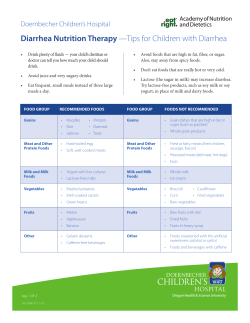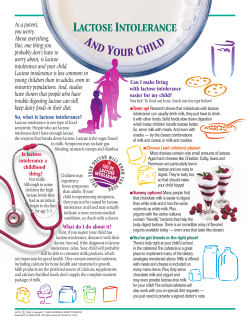
Allergy Information Reintroduction of milk into your child’s diet
Allergy Information Reintroduction of milk into your child’s diet Many children with milk allergy will outgrow their allergy by the time they are 3 to 5 years old. Most children who have symptoms such as colic, reflux, eczema and diarrhoea (non IgE allergy) as a baby, or young child, will start to outgrow this earlier in life, from about 9-12 months of age. Your doctor or dietitian will decide if it is safe to try to reintroduce milk into your child’s diet. For most children it is reasonable to do this at home, a few with very severe reactions or who suffer from bad asthma may need a formal milk challenge in hospital. As the allergy resolves most children will start to tolerate highly cooked milk (e.g. biscuits), followed by lightly cooked milk or milk products, then yoghurt or cheese and then finally plain milk. The quantity of milk that is tolerated often gradually increases. Some people will never be able to tolerate a glass of milk but can eat small quantities of cooked milk or butter without problems. Although most children will outgrow their allergy there is still a small possibility that your child will react to some milk-containing food. To try to keep any reactions as mild as possible please follow these instructions. When to try reintroducing milk: Retry milk when your child is otherwise well. Have some antihistamine (eg Piriton® or cetirizine) available. Do not retry milk for the first time when you are very busy or have an important appointment to go to. Which foods to try: We have divided milk-containing foods into 5 groups, in approximate order of how well tolerated they are (see table on following page- this is sometimes called a 'Milk Ladder') Start with food which is highly processed or highly cooked (Group 1 ) If your child has other allergies (eg egg) remember to check the food is suitable. Page 1 of 3 Healthcare you can Trust How to try the milk-containing food: Try a very small amount of the food first (e.g. pea-size piece of biscuit) and wait for 15-30 minutes before giving your child a second slightly larger portion. Only try a small amount the first day and then try a larger portion the following day. You can then gradually increase to a normal portion. If a highly cooked food is tolerated try other foods from group 1 and continue with this group for about 3 months. You do not need to be as cautious when trying other new foods from these groups but still always have antihistamine available. Following this you can try group 2 starting with foods made with sunflower margarines which contain some milk. You can then try foods from the dairy products group e.g. ¼ teaspoon yoghurt or a tiny piece of cheese. As before wait 15-30 minutes before giving your child a second slightly larger portion. Try a larger portion the following day or later that week. Then try other dairy foods from group 3. Group 4 are cooked foods where milk is a major ingredient. Some children tolerate these before tolerating yoghurt, cheese etc., so you may wish to try these even if there have been minor reactions to group 3. (i.e. mild rashes, tummy ache - not if reactions have been more severe to other groups during reintroduction Wait at least 6 months continuing with cooked milk and dairy products without any reactions before trying any plain uncooked milk starting with very small quantities. (For children who have only had symptoms of colic, reflux or diarrhoea it is usually possible to do this faster). 'The Milk Ladder' Group 1 Manufactured/highly processed foods containing highly cooked cow’s milk Malted milk biscuits Digestive /Garibaldi biscuits (check the labels that they actually have milk) Home-made recipes available- ask your dietitian Group 3 Dairy products Yogurt, cheese, butter, fromage frais Sunflower margarines containing cow's milk proteins may be tolerated before similar quantities of butter. Group 5 Cow’s milk- sterilised milk may be tolerated earlier Start with 1 tablespoon or on cereal Increase amount of cow’s milk Some children will tolerate goat's or sheep's milk before cow's milk Group 2 Cooked homemade food where small amounts of cow’s milk is present Scones, cakes, fruit crumble, Scotch pancakes, Shepherd’s pie Cooked products using standard sunflower margarines containing cow's milk proteins may be tolerated before similar quantities of butter Group 4 Homemade foods containing large amounts of cow’s milk Rice pudding, Yorkshire puddings, pancakes, white sauce. Foods cooked with dried reconstituted milk or sterilised milk may be tolerated earlier than using standard milk. If having less than 400mls of cow's milk, you will still need a milk substitute with added calcium Page 2 of 3 What to do if your child has a reaction: Most reactions occur within 2 hours of the food although eczema sometimes flares after a day or two. If you child has a mild reaction e.g. mild nettle rash, diarrhoea or tummy ache go back to the type of milk your child definitely tolerates. Stay on this type of milk for about 6 months after the reaction before trying new foods again. If the reaction is just mild eczema you may wish to continue with the food. Severe reactions are very unlikely but if your child has a more severe reaction (e.g. breathing difficulties, wheeze) get medical help immediately and discuss with your doctor before considering any further reintroduction Sometimes children will tolerate small amounts of cooked or processed milk but will not tolerate larger amounts, if this is the case you can continue with small quantities if you wish. If you are unclear about when to try new foods discuss this with your doctor or dietician. Some people will never be able to tolerate plain milk but can eat small amounts of cooked milk without problems. Lactose intolerance These guidelines are intended for children who have a resolving milk allergy. Children who have lactose intolerance (inability to digest lactose milk sugar) may tolerate milk products slightly differently as it is not the milk protein causing the symptoms. This condition tends to cause symptoms such as excess wind, abdominal pain or diarrhoea. The lactose levels are not significantly altered by cooking but are reduced in foods such as yoghurt and cheese where the bacteria have reduced the lactose levels. The quantity of the lactose-containing food is of most importance in lactose intolerance. Some people may be able to tolerate small amounts of plain uncooked milk. This quantity tolerated will gradually increase if the condition is temporary, for example after a gastrointestinal infection. There are specific products available from supermarkets and health food shops for people with lactose intolerance. These include lactose-free milk and butter. These products can be very useful for those with lactose intolerance. These are general guidelines and sometimes will be altered by your doctor or dietitian depending on the clinical situation. Discuss this with them if you have any concerns. Date of publication: 23 September 2013 Ref: RUH PAE/028 Ver2 © Royal United Hospital Bath NHS Trust Page 3 of 3
© Copyright 2025












